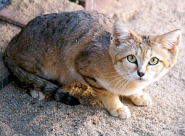 The Sand Cat (Felis margarita) lives in very hot deserts like the Sahara, the Arabian Desert, and the deserts of Iran and Pakistan. Their paws are covered with long fur to protect them from the hot sands. During the night, the sand cat goes out to hunt insects, rodents and lizards. During the day, the sand cat hides in the shadow of rocks. It lives under extreme conditions as the temperatures may rise to about 126ºF (52ºC) during the day and as low as 23ºF (-5ºC) during the night. Most distinctive characteristic is their large pinnae. They use their highly developed ears at locating the underground movements at night of prey. Sand cats are known for their excellent digging capabilities, which they use to dig burrows to escape the heat of the sun. They may also lie on their back outside their burrow to loose internal heat. Sand cats have been known to close their eyes at night when humans approach, making them difficult to see them because their eyes do not lit up.
The Sand Cat (Felis margarita) lives in very hot deserts like the Sahara, the Arabian Desert, and the deserts of Iran and Pakistan. Their paws are covered with long fur to protect them from the hot sands. During the night, the sand cat goes out to hunt insects, rodents and lizards. During the day, the sand cat hides in the shadow of rocks. It lives under extreme conditions as the temperatures may rise to about 126ºF (52ºC) during the day and as low as 23ºF (-5ºC) during the night. Most distinctive characteristic is their large pinnae. They use their highly developed ears at locating the underground movements at night of prey. Sand cats are known for their excellent digging capabilities, which they use to dig burrows to escape the heat of the sun. They may also lie on their back outside their burrow to loose internal heat. Sand cats have been known to close their eyes at night when humans approach, making them difficult to see them because their eyes do not lit up.
Which zoos have them?
Saint Louis Zoological Park (United States)The Sand cat, sand dune cat is listed as Near Threatened (NT), is close to qualifying for or is likely to qualify for a threatened category in the near future, on the IUCN Red List of Threatened Species
Namings for the sand cat
A young / baby of a sand cat is called a 'kitten'. The females are called 'queen' and males 'tom '. A sand cat group is called a 'clowder, clutter, pounce, kindle (young), embarrassment (young),'.Countries
Algeria, Chad, Egypt, Israel, Jordan, Kazakhstan, Kuwait, Morocco, Niger, Oman, Pakistan, Qatar, Saudi Arabia, Turkmenistan, United Arab Emirates, Uzbekistan and YemenSome facts about the
Sand cat
Adult weight : 2.75 kg (6.05 lbs)
Maximum longevity : 14 years
Female maturity :274 days
Gestation : 67 days
Litter size : 5
Litters per year : 2
Weight at birth : 0.056 kg (0.1232 lbs)

Custom Search